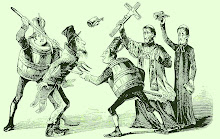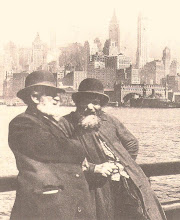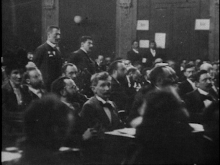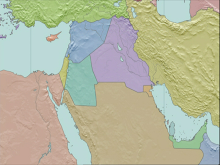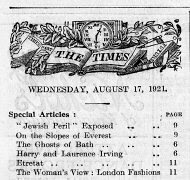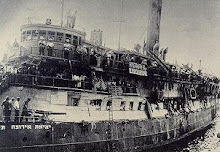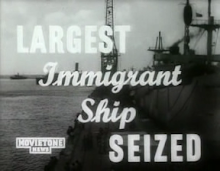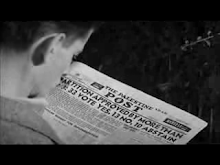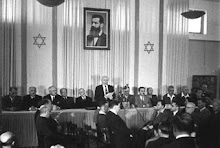Max Nordau is an especially prominent figure, contributor, and historian of the early years of Zionism, and became the movement’s second leader after 1904, following the sudden death of its founder Theodore Herzl. His historical essay, of which notes are presented here, is readily available on the Internet, and his account is regarded as an accurate and sober representation of the first seven years of political Zionism. The essay was written in 1905 and though he lived nearly 20 years after this, he rescinded none of its content.
Its relevance to the Signpost Years cannot be understated. In the design of his essay, he singles out several developmental phases in the process of realizing Herzl’s vision, proposed in 1896, for a Jewish Nation State, re-gathered and reinstated in its former, then Palestinian, homeland after nearly two millennia of absence for its populous. These ‘phases’, of that seven-year history he has bequeathed us, we recount in note form here, directly and in sequence from his own essay.
The emphasis to draw is the focus he brings to bear for the period 1901 to 1903 AD as the culmination point, specifically, in establishing the aims and machinery necessary for the attainment of Zionism’s intention for a Jewish State and re-gathering to the holy Land, and its effective commencement with that epoch.
Though Adam Clarke did not know for sure what to expect, this is directly in harmony with his first advance Signpost Year notification for 1902 AD, based on bible prophecy.
*********************************************
MAX NORDAU: notes and quotes (emphasis added)
AD 70 to 1880.
After the better part of two millennia of stasis, things changed suddenly for the Jews at the beginning of the 1880s with
‘events that rudely awakened the Jews from their illusions of centuries.’
The awakening had been caused by especially violent pogroms that had started at that time, but to which Nordau makes no direct illusions only to note that the thinking of Jewish intellectuals were notably changed by those ‘events’. Leon Pinsker, for example, was suddenly well received when he wrote of the Jews consisting of
‘a nation, needing unification and their own land, for economic, physical and intellectual rebirth.’
Such sentiments had been seriously shunned in previous decades, Nordau points out.
Inspired by this thinking, and terrorised by the pogroms, small groups of Jews had begun to colonise some relatively desolate parts of Palestine (the first Aliyah)
‘but without a uniform plan or clear recognition of aims and methods. They did not see the connection between settlement in Palestine and the future of the entire Jewish people.’
1896 AD
The ‘petty’ and ‘surreptitious’ colonisation was getting no-where and the urgent Jewish situation needed someone with a clear new vision and plan.
‘The man unto whom it was vouchsafed clearly to grasp the idea of which many had a dim presentiment, and to give eloquent expression to the word that many had awaited, now appeared. This man was Dr. Theodore Herzl.’
‘Herzl, with a determination hitherto unknown, declared the Jews a Nation, demanding the Rights of such, and in its own land as a State, at last unfettered by other nations.’
‘There arose everywhere new societies, no longer for the slow, petty colonisation of Palestine by the surreptitious entry of groups of Jews, but for the preparation of a general Jewish immigration into the Holy Land, on the basis of a treaty, guaranteed by the Great Powers, with the rights of self government.’
Importantly, Nordau states that Herzl’s book, “The Jewish State”(1896)
‘became the starting-point of political Zionism – the starting point, not the program. It is still the subjective work of an individual who speaks in his own name. Much was literature only and not clearly delineated between sober social politics and poetical, prophetic fantasy.’
For Nordau, Zionism did not start with Herzl. It would take several years in the fashioning. There would also be much dissention and hostility to overcome.
’The real programme had to be a collective task, founded indeed on Herzl’s book and inspired by his visions, but freed from all fantastic elements and wrought only out of elements of reality.’
1897 AD
Herzl assembles the first Zionist Congress, attended by 204 elected representatives. For the first time ever in the long Diaspora, and globally
‘all countries with a considerable Jewish population were represented by a permanently appointed Executive.’
The ‘colonisation Aliyah’ had, as Nordau notes above, lacked ‘aims and methods’, and the first job was to define what these had to be.
FOUR Zionist Aims, and the Methods for accomplishing these, were produced at the First Congress and agreed upon by vote. They sought to:
1) Promote skilled Jewish settlement in Palestine.
2) Centralise the Jews, via general institutions for commerce, education, communications, and so on.
3) Strengthen Jewish culture, sentiment, nationhood.
4) Obtain gentile sanction for Zionism’s aims.
Importantly, Nordau now lists the following three meetings of Congress, and their task in developing these aims and methods, together as one series.
’The first Congress was followed in the three succeeding years by three further Congresses in 1898 and 1899 again in Basle, and in 1900 in London. At each, succeeding Congress the rules of election were administered more strictly, and the mandates (four aims and methods) were examined more rigorously.’
But separately, and now specified by the months of their occurrence also, he states that following the previous three years of deliberations,
‘the Congress which assembled in December, 1901, for the fifth and in July, 1903, for the sixth time, again in Basle, can rightly claim to form the actual representation of its 180,000 electors.’
Not only had the global representation of Jews from all over the world risen exponentially in numbers, but at these two Congress meetings world Jewry had now agreed and assembled the ACTUAL REPRESENTATION of its mandate, the aims and means by which Zionism would and had just begun to accomplish its intensions.
To prove this point, Nordau now re-lists the four aims and means of the First Congress, and shows in depth how each was now being accomplished by 1901 – 1903 AD, and onward from there.
’A consideration of the following facts will show what the Jews represented at the First Congress have already done to carry out the Zionist programme formulated by the First Congress…’
The interested reader can follow up all four aspects of the mandate’s fulfilment in the second half of Nordau’s essay. He also shows how consolidated the organisation had become in the way it survived the untimely and shock death of its founder and leader, Herzl, in 1904. But the thrust of his essay is now made:
The small aimless ‘colonisation Aliyah’ was getting no-where. But Nordau does not see Herzl as beginning Zionism as such (either), only a catalyst and facilitator. It took collective, and elected, representation from all global Jewry, over several years, to get the program and its machinery, finances, politics, commerce and so on, together. Three years were spent hammering out those details, but then, and only then, the period from December 1901 to July 1903 saw the mandate agreed, actualised and running. Nordau then details how this was demonstrable for each of the four formative aims and means by that time period.
Nordau the secularist, trusted participant-observer of the early modern history of Zionism (and now the State of Israel), exalted in the fact that his political Zionism was exonerated from the contaminating ‘magic’ of religious Zionism. But he unwittingly points us to one of the most important developmental moments in all Jewish history, and strangest of parallel convergences, during 40 centuries of the nation’s entire existence since Abraham. For, wedged firmly between Nordau’s 1901-1903, and PRECISELY continuous with its momentous accomplishment - the total unique change in direction, fortune and co-operation of global Jewry, awakened after two millennia of restless somnambulance, and all its consequential reverberations for today - sits Clarke’s biblically indicated First Signpost Year 1902 AD, foreseen and foretold by him 77 years previously!
This curiosity does not stand by itself for we have noted, and know from history, the momentous voracity of the other Signpost Years for the Jews and the Middle East stand also along with 1902; those encompassing 1917, 1947-8 and 1967. But as if this were not enough, no less an authority than Christ Himself points clearly, it seems, to the first and the last of this Signpost series also.
That we shall discuss next in the following and final notes to the Signpost Years.
Karl Krysko © June 2008






